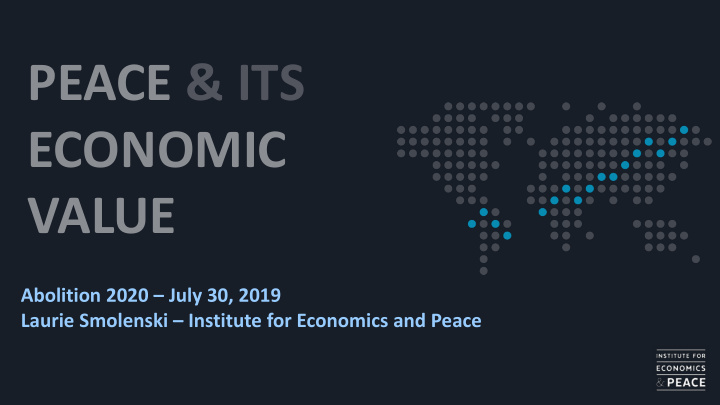



PEACE & ITS ECONOMIC VALUE Abolition 2020 – July 30, 2019 Laurie Smolenski – Institute for Economics and Peace
The Institute for Economics & Peace April June March November December
The global impact of violence, 2019 $14.1 TRILLION Which is equivalent to 11.2% If the world decreased of total world GDP OR violence by 10%... $1.48 TRILLION $1853 Could be directed to per person other economic activities *This is a highly conservative estimate.
Breakdown of the economic impact of violencea Military expenditure accounts for over 40% of the total economic impact of violence. Violent crime, 2.6% Other, 1.0% Conflict, 4.8% 163 Suicide, 5.2% A 1% reduction in the cost of violence Military expenditure, is the equivalent to: 40.2% Private security expenditure, 5.8% total global Official Development Assistance in 2017 Homicide, 8.6% A 10% reduction in the cost of violence is the equivalent to: The global total Foreign Direct Investment in 2018 The third largest economy in the world, Internal security expenditure, 31.7% behind only China and the US Source: IEP
Military expenditure: Total, per capita, % of GDP Military Military Military Expenditure Expenditure Country Country Country Expenditure (Total, $US (Per Capita, (% of GDP) Billions) $US) USA 648 Saudi Arabia 2013 North Korea* 24 China 250 USA 1986 Oman 10 Saudi Arabia 67 Israel 1887 Saudi Arabia 10 India 66 Singapore 1872 Libya 10 France 63 Kuwait 1738 Afghanistan 10 Russia 61 Oman 1389 Palestine 8 UK 50 Norway 1320 Iraq 7 Germany 49 Australia 1078 Syria 6 Japan 46 France 978 Algeria 5 South Korea 43 Bahrain 891 Israel 5 *estimate
What is Positive Peace?
Positive Peace 16 Positive Peace creates the optimum environment for human potential to flourish. 3 High levels of Positive Peace are associated with: Higher per capita income Resilience Better environmental outcomes Higher GDP growth per annum Better performance on MDGs
Positive Peace and economic growth Real GDP growth is correlated with changes in the PPI overall score. 15 REAL GDP AVERAGE ANNUAL GROWTH RATES (%) 10 r = - 0.45 5 0 -5 -0.60 -0.40 -0.20 0.00 0.20 0.40 0.60 0.80 More Peaceful Less Peaceful → POSITIVE PEACE INDEX - OVERALL SCORE, CHANGE (INDEX POINTS) Source: IEP; United Nations
Prosperity gap between high and low peace countries, 2016 In a scenario where low peace countries achieved an average growth rate equivalent to high peace countries, their per capita income would have been over three times higher than it actually was in 2016.
Change in Real Effective Exchange Rates by Positive Peace Group, non-OECD countries, 2005 - 2016
Change in Credit Rating Score by Positive Peace Group, 2010 - 2016
Economics and Peace – Making the Link • Positive Peace provides the framework for robust economic development. • As peace improves, doing business also becomes easier. • Improvements in Positive Peace are linked to strengthening of domestic currencies. • Credit ratings are also more likely to fall when countries experience deteriorations in Positive Peace. • Costs associated with violence expressed as percentage of GDP, increases exponentially as move from most peaceful to least peaceful countries. • Countries that are high in Positive Peace have less volatile economic performances.
Connect with us visionofhumanity.org @GlobPeaceIndex Explore peace indexes, peace research Keep up to date with the latest peace and peace news and articles. news. GlobalPeaceIndex @GlobalPeaceIndex Get the latest news and stories on Like us on Facebook for articles, video Instagram. and other peace related content.
Positive Peace & GDP Every 1% improvement in Positive Peace is associated with a 2.9% growth in GDP per capita. 163
Median Annual Growth in GDP per Capita, 2005 - 2017
Change in Real Effective Exchange Rates by Positive Peace Group, non-OECD countries, 2005 - 2016
Change in Credit Rating Score by Positive Peace Group, 2010 - 2016
Recommend
More recommend